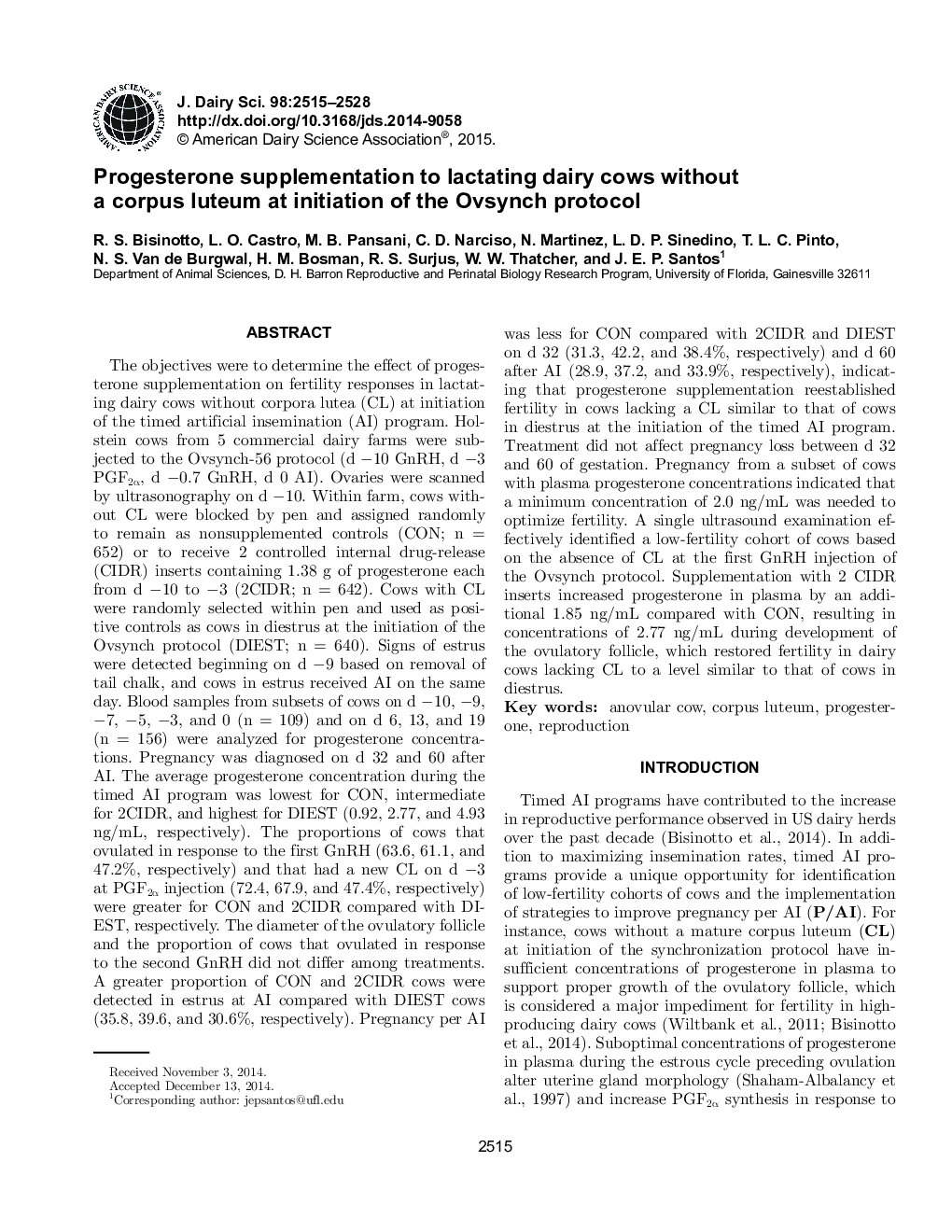| کد مقاله | کد نشریه | سال انتشار | مقاله انگلیسی | نسخه تمام متن |
|---|---|---|---|---|
| 10974777 | 1108028 | 2015 | 14 صفحه PDF | دانلود رایگان |
عنوان انگلیسی مقاله ISI
Progesterone supplementation to lactating dairy cows without a corpus luteum at initiation of the Ovsynch protocol
دانلود مقاله + سفارش ترجمه
دانلود مقاله ISI انگلیسی
رایگان برای ایرانیان
موضوعات مرتبط
علوم زیستی و بیوفناوری
علوم کشاورزی و بیولوژیک
علوم دامی و جانورشناسی
پیش نمایش صفحه اول مقاله

چکیده انگلیسی
The objectives were to determine the effect of progesterone supplementation on fertility responses in lactating dairy cows without corpora lutea (CL) at initiation of the timed artificial insemination (AI) program. Holstein cows from 5 commercial dairy farms were subjected to the Ovsynch-56 protocol (d â10 GnRH, d â3 PGF2α, d â0.7 GnRH, d 0 AI). Ovaries were scanned by ultrasonography on d â10. Within farm, cows without CL were blocked by pen and assigned randomly to remain as nonsupplemented controls (CON; n = 652) or to receive 2 controlled internal drug-release (CIDR) inserts containing 1.38 g of progesterone each from d â10 to â3 (2CIDR; n = 642). Cows with CL were randomly selected within pen and used as positive controls as cows in diestrus at the initiation of the Ovsynch protocol (DIEST; n = 640). Signs of estrus were detected beginning on d â9 based on removal of tail chalk, and cows in estrus received AI on the same day. Blood samples from subsets of cows on d â10, â9, â7, â5, â3, and 0 (n = 109) and on d 6, 13, and 19 (n = 156) were analyzed for progesterone concentrations. Pregnancy was diagnosed on d 32 and 60 after AI. The average progesterone concentration during the timed AI program was lowest for CON, intermediate for 2CIDR, and highest for DIEST (0.92, 2.77, and 4.93 ng/mL, respectively). The proportions of cows that ovulated in response to the first GnRH (63.6, 61.1, and 47.2%, respectively) and that had a new CL on d â3 at PGF2α injection (72.4, 67.9, and 47.4%, respectively) were greater for CON and 2CIDR compared with DIEST, respectively. The diameter of the ovulatory follicle and the proportion of cows that ovulated in response to the second GnRH did not differ among treatments. A greater proportion of CON and 2CIDR cows were detected in estrus at AI compared with DIEST cows (35.8, 39.6, and 30.6%, respectively). Pregnancy per AI was less for CON compared with 2CIDR and DIEST on d 32 (31.3, 42.2, and 38.4%, respectively) and d 60 after AI (28.9, 37.2, and 33.9%, respectively), indicating that progesterone supplementation reestablished fertility in cows lacking a CL similar to that of cows in diestrus at the initiation of the timed AI program. Treatment did not affect pregnancy loss between d 32 and 60 of gestation. Pregnancy from a subset of cows with plasma progesterone concentrations indicated that a minimum concentration of 2.0 ng/mL was needed to optimize fertility. A single ultrasound examination effectively identified a low-fertility cohort of cows based on the absence of CL at the first GnRH injection of the Ovsynch protocol. Supplementation with 2 CIDR inserts increased progesterone in plasma by an additional 1.85 ng/mL compared with CON, resulting in concentrations of 2.77 ng/mL during development of the ovulatory follicle, which restored fertility in dairy cows lacking CL to a level similar to that of cows in diestrus.
ناشر
Database: Elsevier - ScienceDirect (ساینس دایرکت)
Journal: Journal of Dairy Science - Volume 98, Issue 4, April 2015, Pages 2515-2528
Journal: Journal of Dairy Science - Volume 98, Issue 4, April 2015, Pages 2515-2528
نویسندگان
R.S. Bisinotto, L.O. Castro, M.B. Pansani, C.D. Narciso, N. Martinez, L.D.P. Sinedino, T.L.C. Pinto, N.S. Van de Burgwal, H.M. Bosman, R.S. Surjus, W.W. Thatcher, J.E.P. Santos,